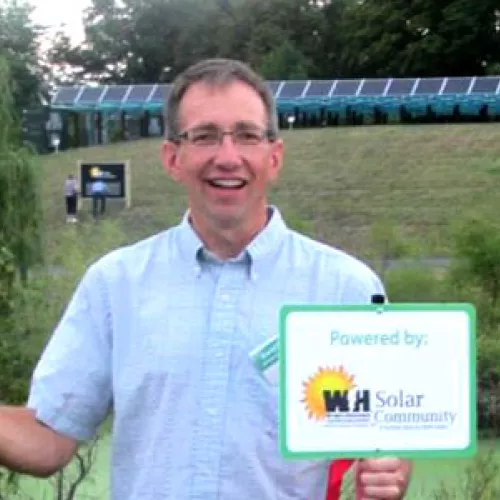Community Solar Gardens are centrally-located solar photovoltaic (PV) systems that provide electricity to participating subscribers, and they’re taking root in Minnesota. Here at CERTs we wanted to learn more about the experiences of subscribers in Minnesota and share them with others who are curious about community solar.
Meet David: David Schmidt is a research engineer at the University of Minnesota and teaches a course on renewable energy. He had already cut back on his energy use at his home in Corcoran, MN and converted to LED lights. For a long time he was intrigued by the idea of generating power from the sun, but had never taken the next step—until community solar came along.
CERTs: Why did you decide to subscribe to the community solar project at Wright-Hennepin Cooperative Electric Association (WHE)?
David Schmidt: Looking at my options, it did not make much sense to purchase a small home system, and I could not afford a system that would generate 50% or 100% of my needs. I purchased just one panel in WHE’s community solar garden in the spring of 2014 as the beginning of a longer term plan to move to 100% renewable. Currently one panel was all I could afford. I also was curious how the contract would work and how the panel would perform.
CERTs: What was the process like to subscribe, and how did you decide how much solar to get?
David: The process was very easy. WHE had an online calculator that showed costs and electricity offsets per panel purchased. Using that tool I could look at the costs and payback and decide how much electricity I could purchase from the community solar garden. I just purchased one panel as that was the right price for me at the time. My plan was to purchase one panel per year. Each 190-watt panel was about $900.
CERTs: What has the impact been on your energy bill?
David: Because I only purchased one panel I was not expecting much impact on my electric bill. The amount the panel produces is deducted monthly from my electric use. My use is around 1200 kWh/month and the panel is producing between 5 and 20 kWh/month so as I said, not much impact on the energy bill. Just an FYI: the reason my electric use is so high is because I am charging my electric vehicle, a Nissan Leaf. My actual home energy use per month is around 600 kWh.
CERTs: What are you doing to tell others about community solar, if anything?
David: I have a small sign (yes the one in the photo) that I put in my yard. I hope that people ask me about it so I can share my thoughts. Also, when I first signed up for a panel I was interviewed by Wright-Hennepin Cooperative Electric Association and their article appeared in some other newspapers including USA Today!
CERTs: What would you tell a friend if they asked about community solar gardens?
David: I have encouraged several of my friends and family members to check out community solar. I tell them how much more empowered I feel by being able to choose how my electricity is generated (I also purchase wind energy from WHE, about 700 kWh/month). I tell them that there are some extra initial costs involved but that it is a small price to pay for cleaner energy. We all have choices on how we spend our money. I like to think I am making the right choice by spending some of my money on clean electricity.
David was featured in this story on KARE11 News:
To learn more about the WHE Solar Community, click here to visit their website. You can also check out the map, photos, and video below.
Community solar garden location:
Photos from installation:
Time-lapse video of installation:
More interviews with community solar subscribers:
- Rachel and John Egan of Blaine, MN
- Eric Schilling and family of Ham Lake, MN
- Douglas and Dennis Falch of Winona, MN
- Christine and Tom Custer of Brownsville, MN
- Jim and Carol Johnson of Pelican Rapids, MN
- Gary and Betty Dagen of Barnesville, MN
 |
The Get Answers series on the Energy Stories Blog offers useful tips from CERTs and our partners to help you get to the bottom of your energy efficiency and renewable energy questions. Click here to see more stories in the series >> |



